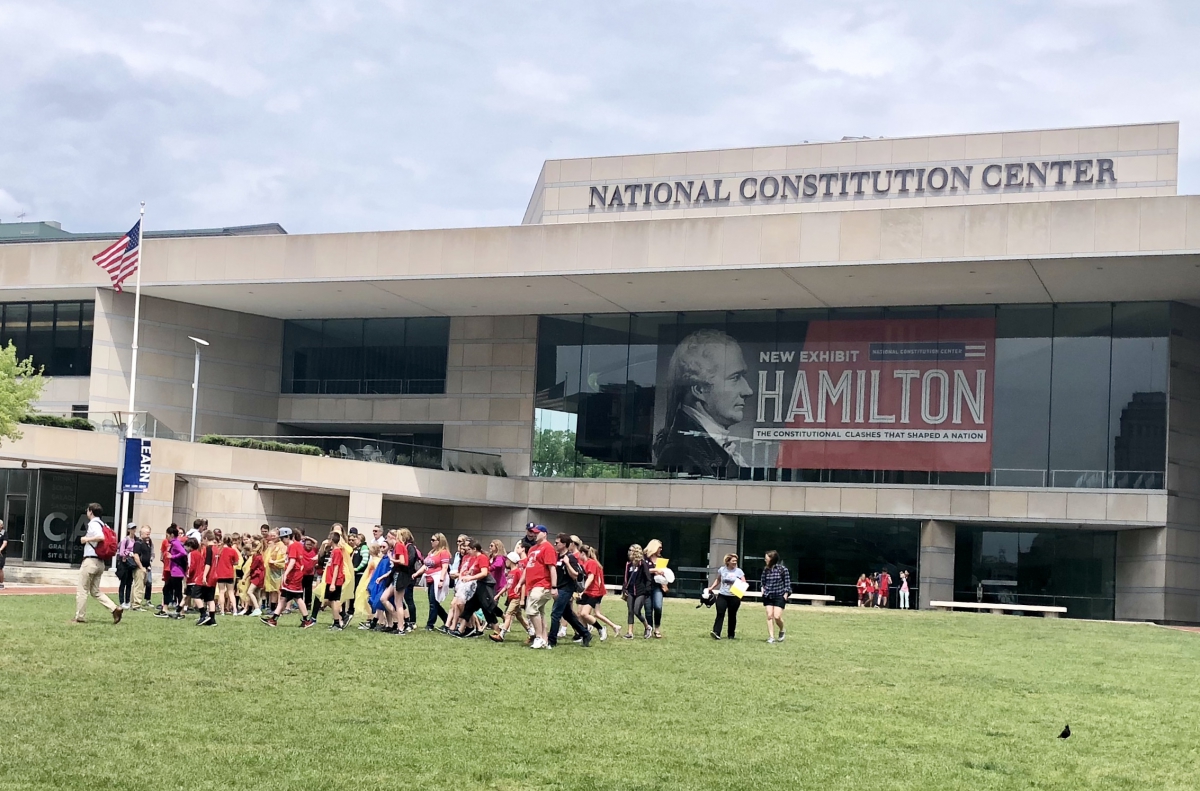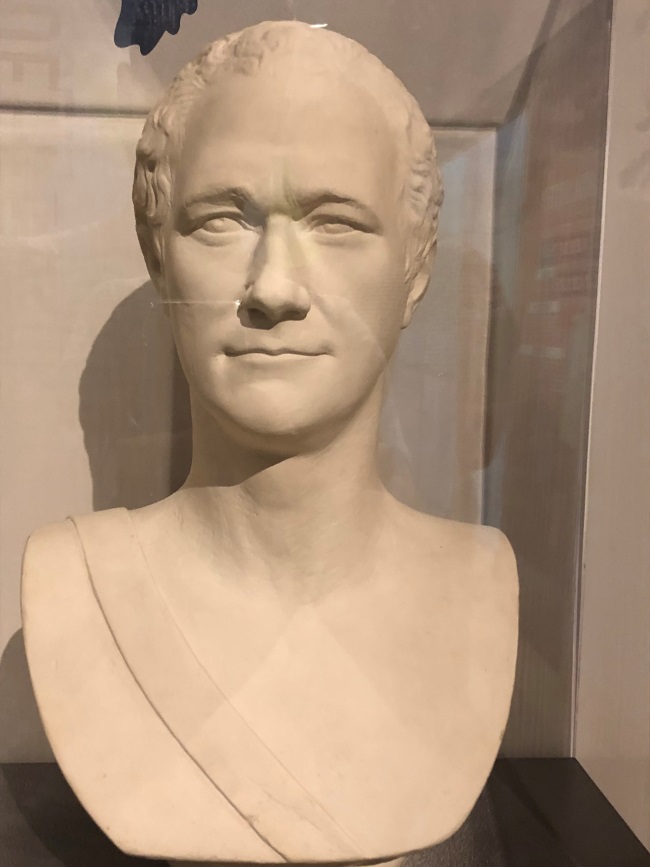Alexander Hamilton: The Constitutional Clashes That Shaped a Nation Exhibit
Posted on Friday, July 13, 2018
Guest Blogger: Andrew Terranova, Concierge, Sofitel Philadelphia
Related Posts:
- Alexander Hamilton in Philadelphia - Our blog on where you can find traces of Alexander Hamilton and the years he spent in Philadelphia.
- Buy Tickets for The Constitutional Walking Tour of Philadelphia – See 20+ Sites on Primary Overview of Independence Park
At Fifth and Arch Streets stands a wonderful, hands-on museum. Before you walk in, you will see those famous three words inscribed on the wall – “We The People…”. Truly, the story you’re about to experience is the story of we the people, and you are one of “we the people.” The National Constitution Center opened its doors on July 4, 2003, and today it is one of Philly’s most visited attractions – and for good reason. Now on display is a wonderful exhibit about our “Ten Dollar Founding Father,” Alexander Hamilton.

While now his name is synonymous the main character in the extraordinary Broadway hit “Hamilton the Musical” written by Lin-Manuel Miranda, it may be easy to lose track of the fact that Hamilton was a real person who lived and worked in Philadelphia for a major part of his life. You can experience his professional career at Hamilton: The Constitutional Clashes That Shaped A Nation, which is a special limited time exhibit at the National Constitution Center that runs through December 31, 2018. The Hamilton exhibit highlights the competing ideas of Alexander Hamilton and his legendary rivals.

The History
Founding Father Alexander Hamilton was born circa January 11, 1755 or 1757 (the exact date is unknown), on the island of Nevis in the British West Indies. While he was born into poverty, Hamilton went on to become a soldier, author, congressman and the only signer of the United States Constitution who was from New York.
In 1777, Hamilton became General George Washington's assistant. In 1788, Hamilton convinced New Yorkers to ratify the U.S Constitution, and he then served as the United State's first Secretary of the Treasury, from 1789 to 1795.
Hamilton’s greatest political victory was the establishment of a Federal banking system.
Hamilton’s banking system was criticized by small government focused, southern agrarians such as James Madison and Thomas Jefferson, and sparked the nation’s first great Constitutional Debate regarding the interpretation of the United States Constitution. As America began to operate under its new Constitution, two different factions, with strongly contrasting beliefs began to emerge.
A faction known as the Federalists was led by Founding Fathers such as Alexander Hamilton and John Adams, and they applied a more liberal interpretation to the United States Constitution and supported a stronger central government. Hamilton and Adams were opposed by another faction known as the Democratic-Republicans, led by Founding Fathers such as Thomas Jefferson and James Madison who had a much more conservative view of the Constitution and championed states’ rights.
After Alexander Hamilton, the first Secretary of the Treasury, proposed a National Bank in 1791,the concept ignited the first major clash between the two factions – the liberals and conservatives. Both Alexander Hamilton and Thomas Jefferson pled their cases to President George Washington, with Washington eventually siding with Hamilton, and to that end, Congress and President Washington chartered the First Bank under the direction of Alexander Hamilton in 1791.
Alexander Hamilton’s financial ideas set the groundwork for the financial system with the U.S. Treasury Department that we still use today in the United States.
One of Hamilton's famous quotes was, "Give all power to the many, they will oppress the few. Give all power to the few, they will oppress the many."
On July 12, 1804, in New York City, Hamilton died of a gunshot wound that he sustained during a duel with Vice President Aaron Burr.
What to See
A good portion of artifacts pertaining to Hamilton’s life are on display at the Constitution Center for you to enjoy. You will see such artifacts such as replicas of the dueling pistols used on that infamous day on July 12, 1804, a lock of Hamilton’s hair, personal artifacts and the very writing desk that he used to write the ubiquitous Federalist Papers, which were a kind of an editorial endorsing our the Constitution of the United States.
Hamilton, an avid self-promoter (which infuriated peers such as John Adams and Thomas Jefferson) wrote the incredible words in the Federalist Papers, “To all general purposes we have uniformly been one people, each individual citizen everywhere enjoying the same national rights, privileges, and protection.”
No Love Lost Between Alexander Hamilton and John Adams
John Adams, the first Vice President of the United States (1789-1797)and second President of the United States (1797-1801), was no fan of Alexander Hamilton, having the audacity to write, “What a pity it is that our Congress had not known this discovery, and that Alexander Hamilton’s projects of raising an army of fifty thousand Men, ten thousand of them to be Cavalry and his projects of sedition Laws and Alien Laws and of new taxes to support his army, all arose from a superabundance of secretions which he could not find whores enough to draw off! and that the same vapours produced his Lyes and Slanders by which he totally destroyed his party forever and finally lost his Life in the field of Honor.”
There was no love lost between Adams and Hamilton. Adams also took digs at Hamilton’s illegitimacy once too often. With hindsight, it appears that little in politics has changed today, since politicians still say arguably slanderous things about one another. The big difference is that in 1787, our Founding Fathers put away their derision and detest of one another and made a miracle happen.
After the exhibit, explore the rest of the offerings of the NCC, including Freedom Rising, a multi-media presentation about how the Constitution of the United States affects our everyday life, and then meet the Founding Fathers of the Constitutional Convention and take selfies with them in Signers’ Hall.
Insider Tip
Talk to the Constitution Center docents! They are an invaluable resource of information about the Constitutional Convention. In Signers’ Hall, we met a wonderful docent named Jon who really filled our spirits with enormous pride and wonderment about what happened during the Constitutional Convention in that almost magical time at Independence Hall in Philadelphia from May to September 17, 1787.
Many Founding Fathers, including James Madison, Benjamin Franklin, George Washington and Alexander Hamilton all had differing viewpoints about what they wanted to accomplish. Ostensibly, the goal of the Constitutional Convention was to rework and improve the Articles of Confederation. But Hamilton and Washington had different designs – specifically to overhaul the entire form of government in the new United States of America. On September 17, 1787, the U.S. Constitution – which still serves as the guiding legal framework for the United States, was signed. We also learned that at the Constitutional Convention, the idea of checks and balances was conceived to help avoid the rise of monarchs and dictators. You can “meet” all the delegates of the Constitutional Convention in Signers’ Hall with the life-size bronze replicas of these great men.
After about a couple of hours visiting the Hamilton exhibit and seeing the other exhibits at the Constitution Center, you will walk away with a new appreciation for these incredible men. Imagine the debates, the feuds, the reconciliations, many of these roadblocks which took place in Independence Hall in the summer of 1787.
Now imagine it with powdered wigs, no air-conditioning and the smell of horse manure piercing the neighborhood. DC’s politicians today don’t know how well they have it compared to what the Founding Fathers experienced during Hamilton’s time. If Hamilton were alive today, no doubt he would remind us all that “there is a certain enthusiasm in liberty, that makes human nature rise above itself, in acts of bravery and heroism.” Brave, heroic, proud – and just a little bit narcissistic, all these qualities and flaws about a fascinating man have come to life at the National Constitution Center.
How to Get There
Guests of The Constitutional Walking Tour will find the Hamilton exhibit “The Constitutional Clashes That Shaped a Nation Exhibit” especially convenient since The Constitutional Walking Tour begins and ends at the National Constitution Center. Many of The Constitutional Walking Tour’s guests have decided to visit the Constitution Center right before or after taking The Constitutional. Along The Constitutional Walking Tour, guests will visit more than 20 of the most historic sites including the Liberty Bell, Independence Hall and the First Bank of the United States where you will learn more about Alexander Hamilton.
The National Constitution Center is conveniently located parallel to Independence Hall, bookending the Independence National Historical Park area on Arch Street between 5th and 6th. The Market-Frankford subway line stops at 5th and Market, one block away.
Hours
Monday through Saturday 9:30AM to 5PM
Sunday 12PM to 5PM
Additional Information
National Constitution Center
525 Arch Street
Philadelphia, PA 19106
215.409.6700
Credits
Author: Andrew Terranova
Photos: Eric Furman
Blog tags:



